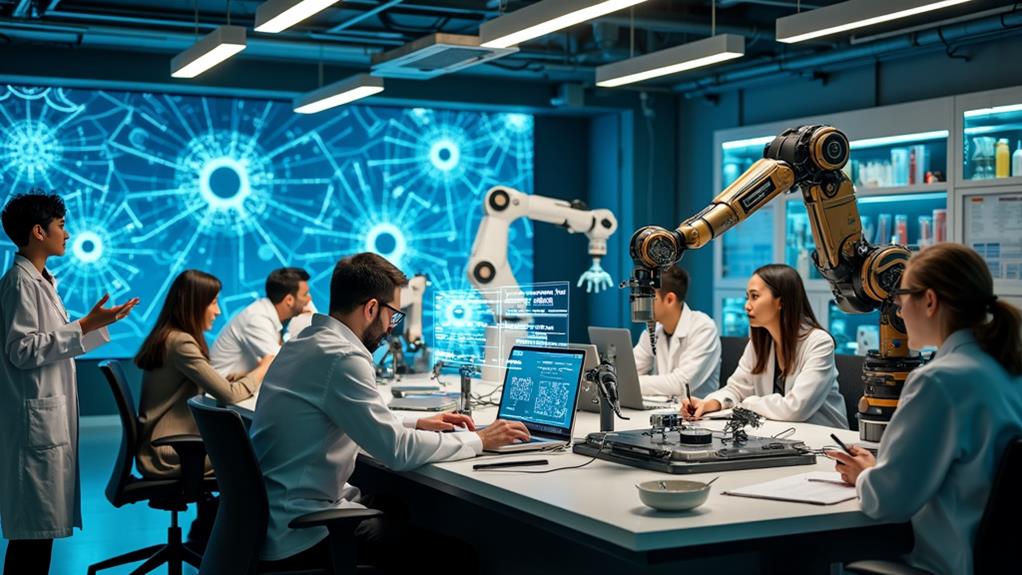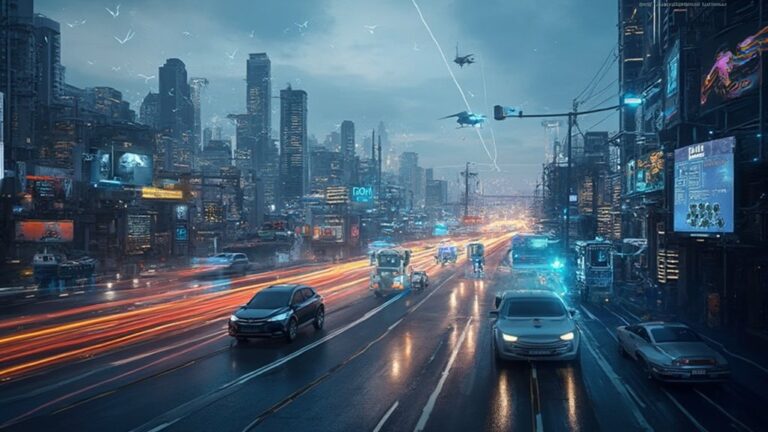Collaboration between robotics and AI is the secret sauce transforming our world by enhancing safety, boosting productivity, and sparking innovation. Imagine cobots working safely alongside humans, making workplaces more efficient and less prone to accidents. They handle mundane tasks, freeing us to release our creativity. AI-driven robots are not just science fiction; they’re boosting productivity in industries like logistics and healthcare, streamlining operations and improving outcomes. Plus, they’re reshaping the job market, creating exciting new roles. Ensuring ethical use keeps this tech trustworthy and effective. As robots continue to learn and adapt, the potential for groundbreaking advancements is immense. By exploring further, you’ll uncover more about this thrilling frontier! To further maximize the potential of robotics and AI, there is a growing trend towards creating virtual assistants for AI automation. These virtual assistants are designed to streamline and simplify the implementation and management of AI systems, allowing businesses to easily incorporate these advanced technologies into their operations. By leveraging virtual assistants for AI automation, organizations can stay at the forefront of technological advancements while also ensuring that the integration of robotics and AI remains ethical and effective.
Table of Contents
Key Takeaways
- AI-driven cobots enhance workplace safety by detecting human presence and adjusting actions autonomously.
- Collaborative robots improve efficiency and productivity, allowing humans to focus on higher-value tasks.
- AI and robotics integration drives significant operational gains and cost reductions for businesses.
- New job roles and continuous learning opportunities emerge from AI and robotics advancements.
- Ethical frameworks ensure responsible AI deployment, fostering trust and transparency in robotics.
Enhancing Safety With AI
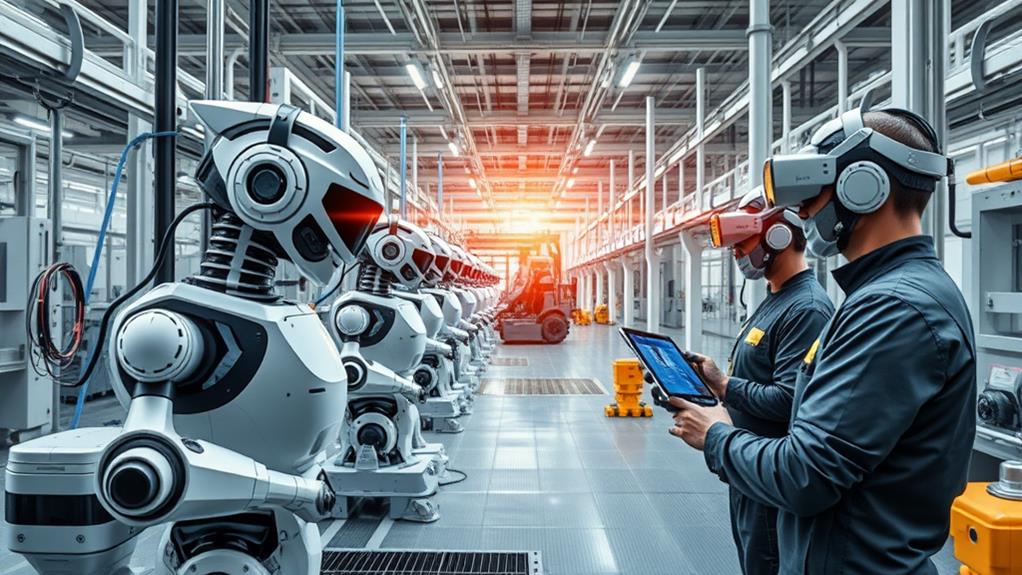
In the domain of industrial automation, enhancing safety with AI has become paramount, particularly through the deployment of collaborative robots (cobots) equipped with advanced technologies.
Imagine a workplace where robots seamlessly work alongside humans without posing any danger. Thanks to AI-driven 3D machine vision, this is now a reality. These cobots can identify human presence and obstacles in real-time, making our workspaces safer than ever.
Cobots are not just smart; they’re considerate. Equipped with sensors, they can autonomously adjust their speed or even stop when detecting nearby humans. This drastically reduces the risk of accidents, making human-robot collaboration both efficient and safe.
And let’s not forget their soft components—designed to minimize injury risk in case of accidental contact.
But the innovation doesn’t stop there. Research on context-aware cobots is pushing the envelope by predicting worker movements, which means these machines can anticipate potential hazards in dynamic environments.
AI integration allows these cobots to adapt to environmental changes without the need for retraining, ensuring safety standards are maintained as workspaces evolve.
In short, AI is transforming cobot safety, making our industrial environments not just smarter, but safer.
Boosting Productivity
Beyond enhancing safety, AI-driven collaborative robots (cobots) considerably boost productivity in industrial settings. By merging the strengths of human workers with the precision of AI in robotics, companies are witnessing unprecedented efficiency.
Studies show that mixed teams of humans and robots can alleviate monotonous tasks, allowing employees to tackle complex duties that demand creativity and problem-solving.
Imagine a warehouse where cobots equipped with advanced AI algorithms handle repetitive tasks with impeccable accuracy. This not only frees up human workers to focus on higher-value activities but also results in fewer errors and faster operations.
Companies have reported significant productivity boosts, with an order-fulfillment firm experiencing a 30% surge during the pandemic, thanks to cobots.
The secret sauce here is the continuous learning capability of AI. Cobots can learn from operational data, refining their performance over time.
Whether it’s packaging goods or managing autonomous vehicles, the collaboration between humans and cobots is transforming productivity landscapes. The future looks bright as AI in robotics continues to evolve, making our work environments smarter and more efficient.
Creating Business Value
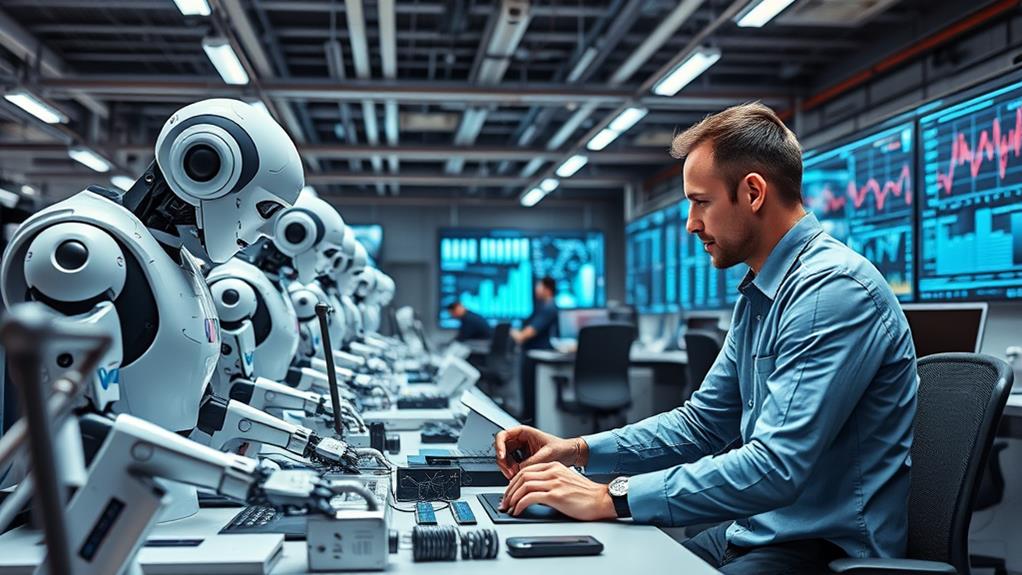
Creating business value through the integration of AI in robotics is a game-changer, enhancing operational efficiency and driving competitive advantage.
Imagine a world where robots handle mundane tasks, freeing up human talent to tackle more strategic, fulfilling roles—resulting in a happier, more productive workforce.
Companies leveraging AI-driven cobots have not only seen impressive gains, like a 30% increase in operations during the pandemic, but are also setting the stage for future growth and innovation.
Enhancing Operational Efficiency
Collaborative robots, or cobots, are revolutionizing operational efficiency by taking over repetitive manual tasks, thereby freeing up human workers to concentrate on higher-value activities.
Imagine a workplace where robots and Artificial Intelligence work hand in hand with humans, enhancing operational efficiency and leveraging human capabilities to their fullest potential. It’s not just sci-fi; it’s happening now.
AI-driven robots are capable of performing mundane tasks with speed and precision. This collaboration allows human workers to focus on creative and strategic roles, greatly boosting job satisfaction and productivity.
For instance, a study found that teams composed of both humans and robots achieved the highest efficiency rates while experiencing fewer accidents. This means a safer, happier, and more productive work environment—what’s not to love?
Moreover, companies adopting AI-driven cobots have reported impressive results. Take an order-fulfillment company that saw a 30% business surge during the pandemic, thanks to these intelligent machines.
Advanced algorithms like “Act, Delegate, or Learn” guarantee ideal task allocation, continually improving performance based on data analysis.
Strategic investments in cobots and their AI integration not only streamline operations but also drive revenue growth and cost reductions.
Driving Competitive Advantage
As operational efficiency improves through the integration of AI-driven cobots, businesses can harness these advancements to drive competitive advantage. Imagine a world where AI intelligence and human employees work side by side, seamlessly blending strengths. This isn’t science fiction; it’s happening now, and it’s spectacular.
Consider the following:
| Benefits | Example |
|---|---|
| Increased Productivity | Mixed teams achieving 30% higher productivity |
| Revenue Growth | Logistics firm saw 30% business surge during the pandemic |
| Autonomous Adaptation | Cobots adjusting to changing environments without retraining |
Such integration doesn’t just boost productivity; it propels companies into the future. When AI is used to enhance robotic navigation, the reduction in accidents combined with increased efficiency creates a safer and more productive workspace. These cobots adapt autonomously, meaning less downtime and more uptime.
Investing in AI-driven robots to navigate complex environments guarantees businesses can maintain high productivity without the constant need for human oversight. This translates to cost reductions and risk mitigation, providing clear competitive advantages. The continuous evolution of AI in robotics is not just about keeping up with the times—it’s about leading the charge and setting new industry standards. So, ready to navigate the future?
Transforming the Workforce
The transformation of the workforce through the integration of AI and robotics is redefining job roles and necessitating new skills. Gone are the days when robots were merely science fiction; today, AI empowers robots to work alongside humans, creating a dynamic collaboration that meets modern workforce demands.
This synergy between humans and robots doesn’t just streamline operations—it elevates job satisfaction by allowing employees to focus on more meaningful tasks rather than mundane, repetitive labor.
Consider this: a study of 1,500 firms revealed that the greatest performance improvements come from teamwork between humans and AI. Who knew that robots could be such great colleagues? This collaboration is generating entirely new job roles, such as machine learning engineers and AI ethics specialists, proving that automation isn’t about job displacement but evolution.
Historical parallels with the Industrial Revolution show that while automation reshapes job landscapes, it also opens doors to opportunities in training, data management, and AI monitoring.
Continuous learning becomes the cornerstone of thriving in this AI-enhanced environment. Companies investing in employee development for the human-machine interface are setting the stage for future success, fostering a culture of perpetual growth and adaptation.
Industry Innovations
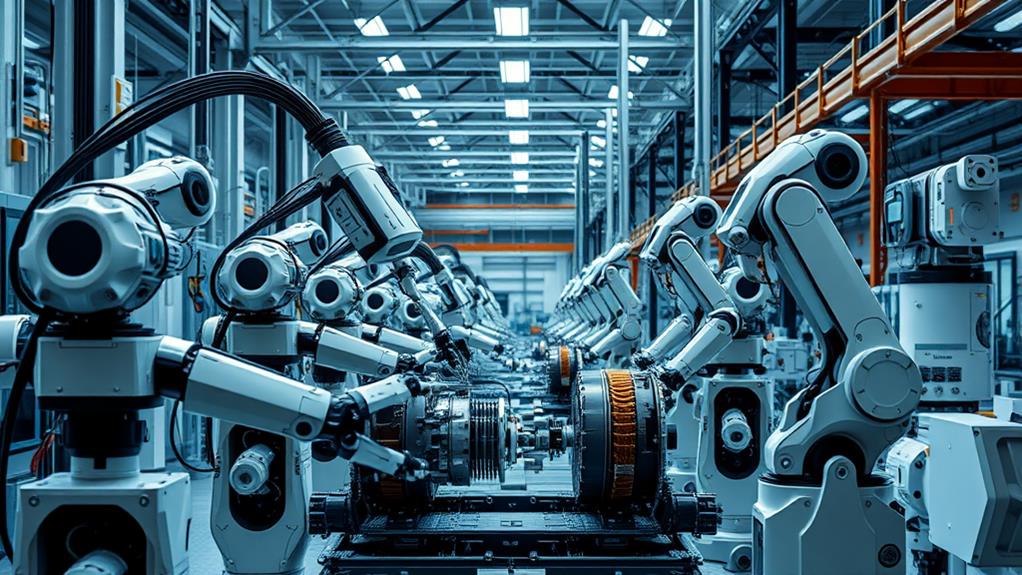
Building on the transformative impact of AI and robotics on the workforce, their integration has spurred remarkable industry innovations that are reshaping operational landscapes.
In manufacturing, the collaboration between robotics and artificial intelligence has led to the creation of cobots—robots working alongside humans. These AI-powered cobots have boosted productivity by up to 30%, especially during the pandemic, by optimizing labor-intensive processes and minimizing human error. Imagine a factory running smoother than a Swiss watch!
In healthcare, AI-driven robotic systems are game-changers. They assist in surgeries with precision that even the steadiest human hand can’t match, improving patient outcomes and making hospital operations more efficient. It’s like having a surgical team where everyone is a perfectionist!
Transportation, too, has seen revolutionary strides. Autonomous vehicles, powered by AI, navigate and avoid obstacles in real time, making roads safer and journeys more efficient. Talk about a smart commute!
The agricultural sector isn’t left behind either. AI-powered robotic systems monitor plant conditions and optimize resources, boosting crop yields and tackling labor shortages. It’s high-tech farming at its best, ensuring we have our veggies and eat them too!
All these industry innovations highlight the incredible potential when robotics and artificial intelligence join forces.
Ethical Considerations
Guiding the intersection of robotics and artificial intelligence brings to light numerous ethical considerations that demand rigorous scrutiny. Imagine a world where robots make decisions impacting human lives. Who’s responsible when things go awry? Accountability is essential. We must guarantee every decision made by AI systems in robotics can be traced back to human oversight to prevent harmful outcomes.
Transparency is another biggie. Users and stakeholders need to trust the AI, especially in high-stakes areas like healthcare and self-driving cars. It’s like asking a friend for advice—you want to know they have your best interest at heart, right?
| Ethical Consideration | Importance |
|---|---|
| Accountability | Prevents harmful outcomes and guarantees human oversight. |
| Transparency | Builds trust among users and stakeholders. |
| Regulatory Frameworks | Guarantees compliance with ethical standards and societal values. |
AI algorithms can be tricky, often perpetuating biases if unchecked. Developing ethical frameworks is significant to address these biases and avoid discrimination in robotics. Regulatory frameworks are the backbone here, establishing guidelines to guarantee responsible AI usage.
Lastly, continuous engagement with diverse stakeholders—including ethicists, policymakers, and the public—is imperative. We must stay ahead of evolving ethical challenges posed by AI in robotics.
Future Prospects
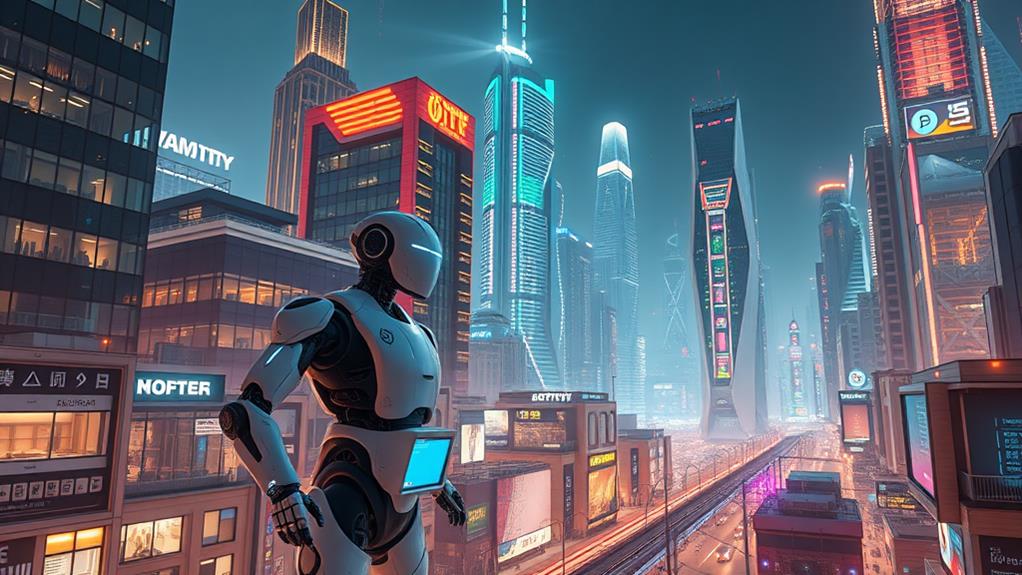
Looking ahead, the future of AI in robotics holds incredible promise, with robots becoming capable of learning and adapting to increasingly complex tasks through advanced algorithms.
As these technological marvels gain autonomy, they will revolutionize industries by boosting efficiency and productivity, all while raising important questions about ethical AI deployment.
Ensuring that robots are developed responsibly will be essential to fostering trust and transparency, paving the way for a seamless integration of cobots into our daily work lives.
Advanced Task Adaptability
The future of advanced task adaptability in robotics is poised to revolutionize a multitude of industries through the seamless integration of AI-driven capabilities. Imagine cobots that aren’t just programmed for one repetitive task but can adapt, learn, and excel across various tasks with astonishing flexibility. This isn’t sci-fi; it’s the next leap in artificial intelligence and robotics collaboration.
Advanced algorithms, such as “Act, Delegate, or Learn,” empower AI-driven cobots to enhance performance over time by processing real-time data and experiences. These robots can autonomously adjust their speed and navigation in dynamic environments, ensuring workplace safety by responding adeptly to human presence and obstacles. Talk about multitasking!
Moreover, once these cobots map their environment, they don’t need constant retraining to adjust to minor changes, showcasing their incredible efficiency. Their context-aware capabilities allow them to predict worker movements, fostering a proactive and harmonious collaboration in any workspace.
Future advancements in AI promise even greater autonomy, enabling robots to tackle complex tasks across sectors like manufacturing and healthcare. This paradigm shift toward advanced task adaptability isn’t just about smarter robots; it’s about creating a more productive and innovative future.
Ethical AI Deployment
Anticipating the future of ethical AI deployment in robotics necessitates the establishment of robust regulatory frameworks to guarantee responsible usage and accountability. This isn’t just about ticking boxes; it’s about ensuring that AI-driven decisions are fair, transparent, and trustworthy.
A future where robots make decisions independently sounds exciting, but it also raises eyebrows—rightfully so.
To navigate these waters, we need to focus on a few key areas:
- Regulatory Frameworks: Crafting solid guidelines and standards is fundamental. These frameworks will act as a safety net, ensuring responsible usage and accountability.
- Continuous Improvement: AI models must evolve. Addressing biases and enhancing transparency in robotic applications can mitigate ethical concerns.
- Stakeholder Engagement: Bringing together technologists, ethicists, and policymakers is essential. Collaboration breeds innovation and trust in AI technologies.
- Ethical Guidelines: Developing clear ethical guidelines is important for building trust. When people trust AI, they are more likely to embrace it.
Frequently Asked Questions
Why Is Artificial Intelligence Important in Robotics?
Artificial intelligence is essential in robotics due to AI advancements that enable machine learning, intelligent design, and autonomous systems, enhancing robotics integration. This fosters efficient human-robot interaction and boosts productivity through advanced perception and decision-making capabilities.
How Does AI and Robotics Work Together?
AI and robotics synergize through machine learning and sensory fusion, enhancing robot perception for autonomous navigation and task optimization. This collaboration fosters advanced human-robot interaction, enabling innovative, efficient, and independent operations in dynamic environments.
How Does AI Help With Collaboration?
AI tools enhance human interaction by optimizing workflows through advanced data analysis and predictive decision-making. This fosters efficient problem-solving, enabling seamless collaboration between humans and robots, ultimately improving productivity and safety in shared work environments.
What Is One Advantage of Having Robots and AI in the Modern World?
One advantage of having robots and AI in the modern world is the significant enhancement in robot efficiency and task automation, leading to enhanced precision, cost reduction, safety improvements, and robust decision support, ultimately fostering innovation and productivity.
Conclusion
In conclusion, the collaboration between robotics and AI is not just a technological advancement but a revolutionary shift impacting safety, productivity, business value, workforce dynamics, and industry innovations. Ethical considerations must guide this transformation to guarantee a beneficial and inclusive future. The synergy between these fields promises a future brimming with potential, driving progress and opening new horizons. Embracing this fusion is essential for steering through the complexities of tomorrow’s world.

